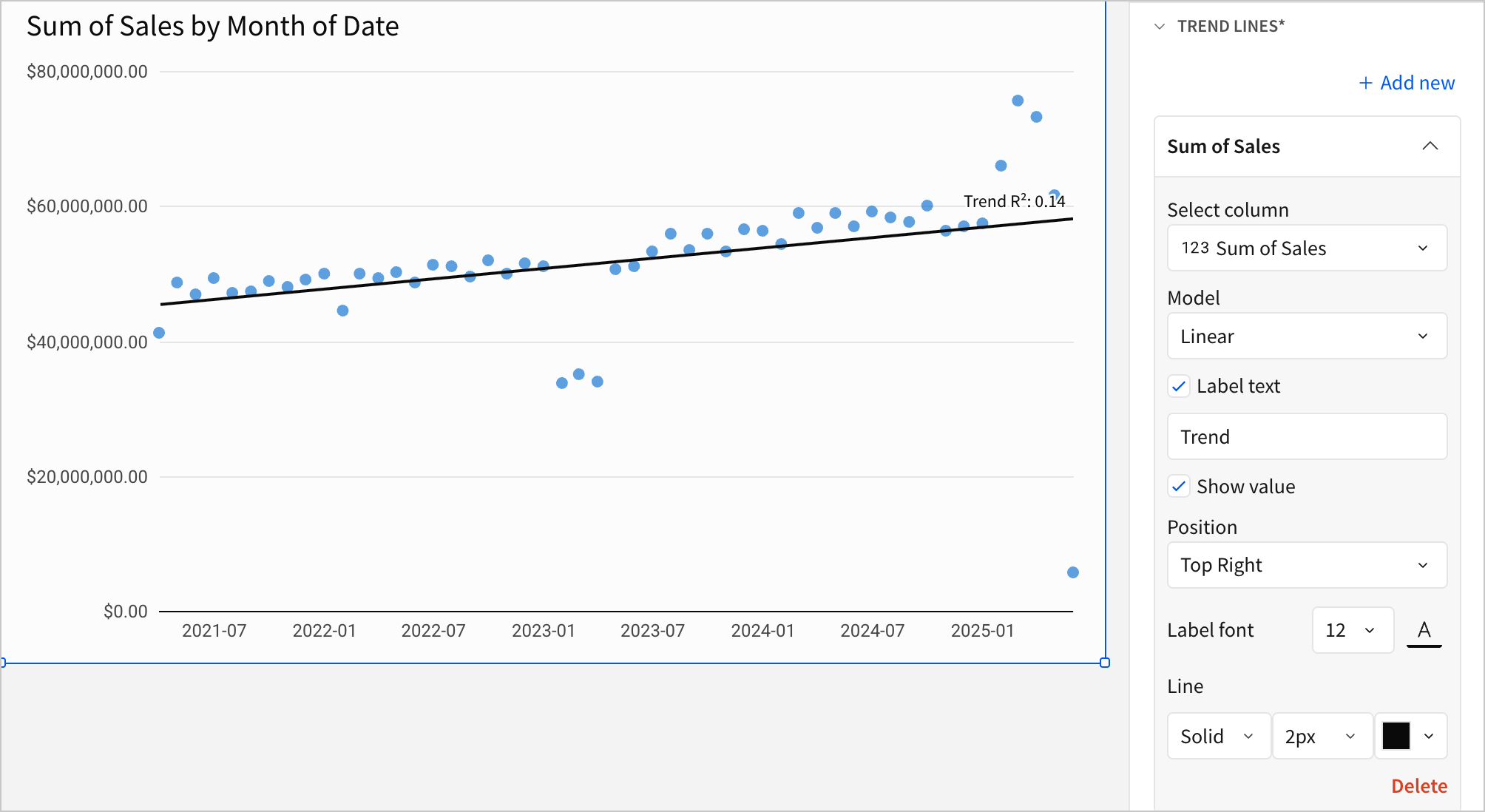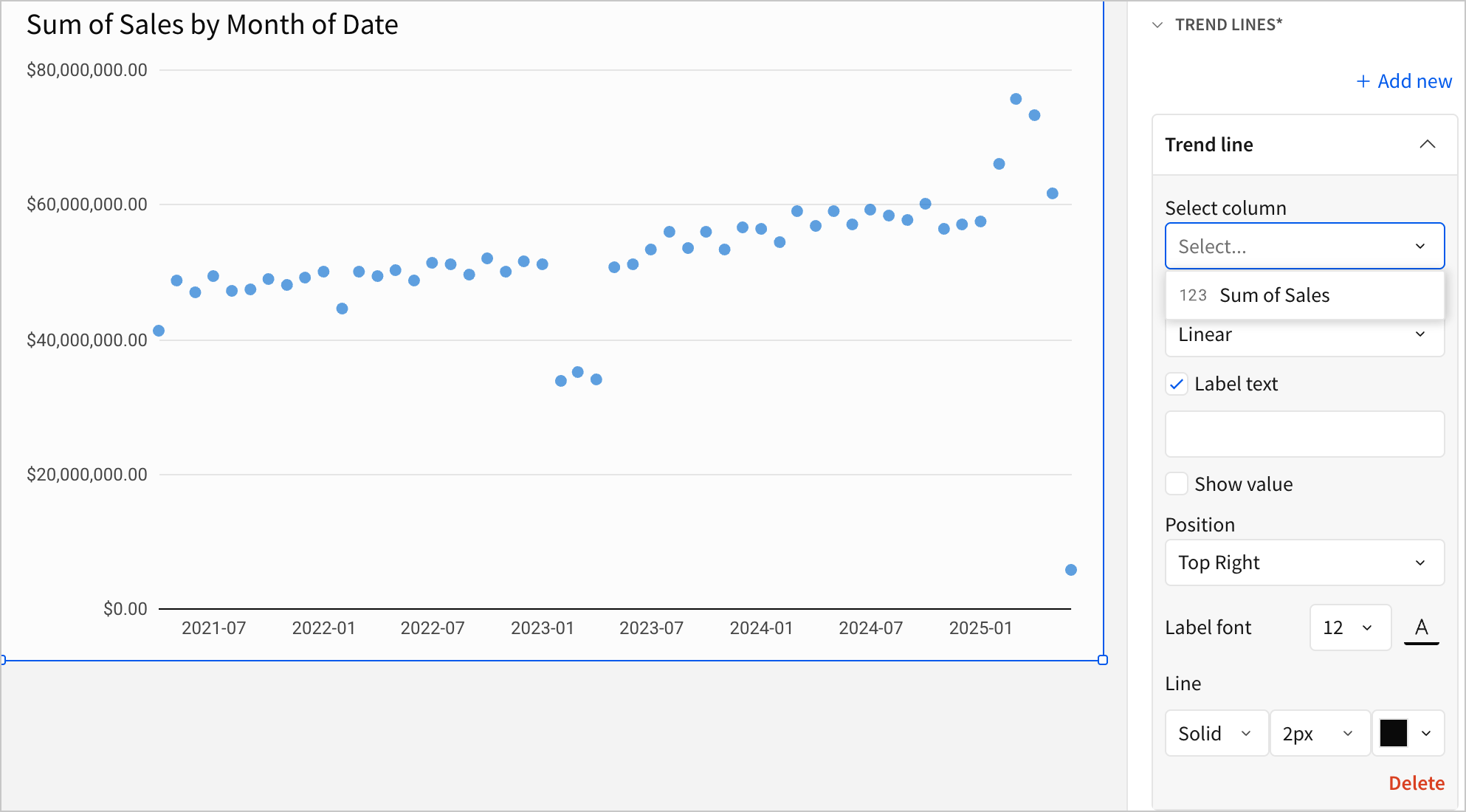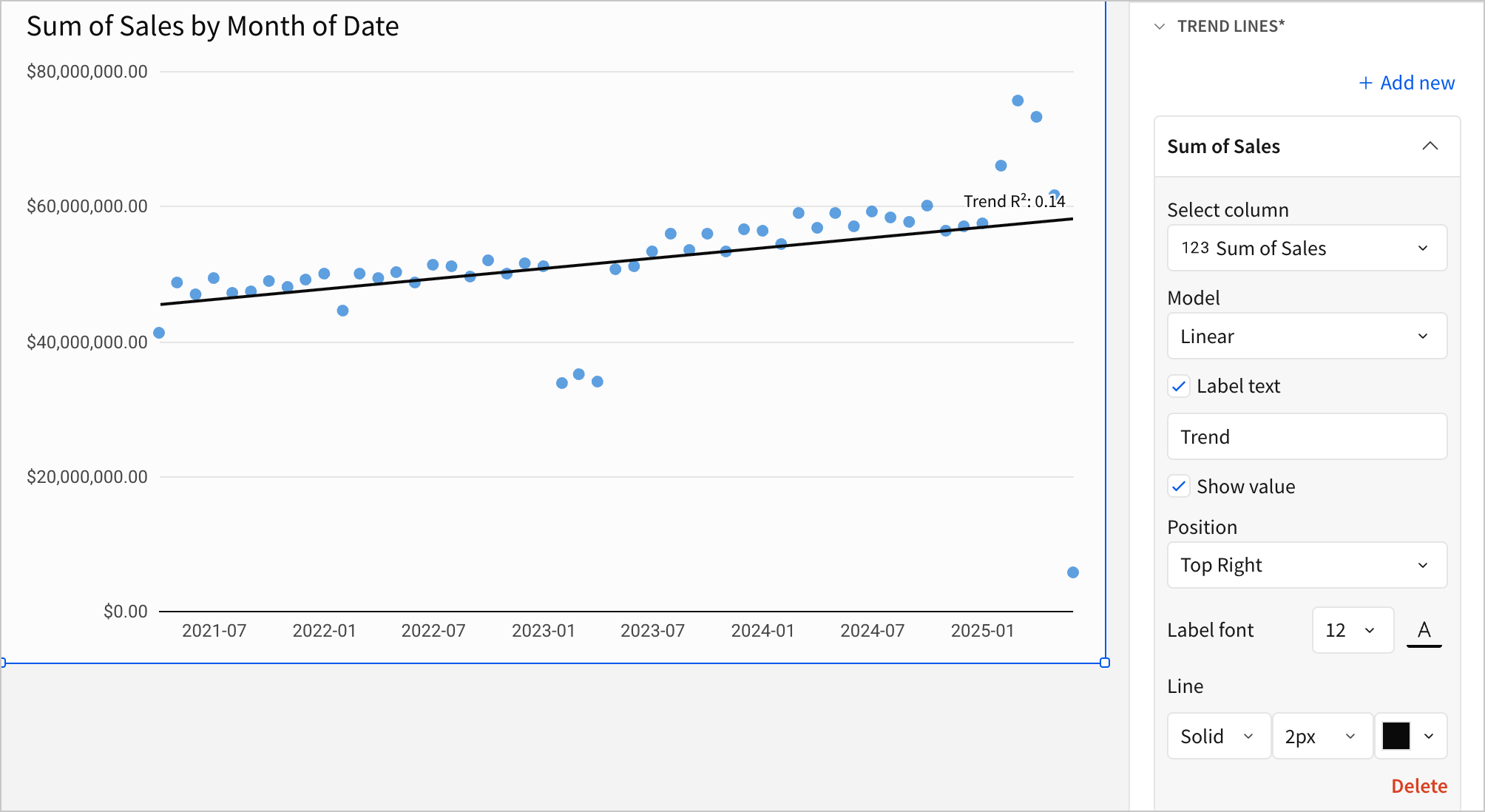Add trend lines
Trend lines are lines added to charts to highlight and predict patterns across multiple values in a set of data. For example, you may want to track your company's overall pace of revenue growth over the past 5 years.
This article describes how to add, edit, and delete trend lines in charts.
User requirements
- To edit a chart, you must have Can edit or Can explore access to the individual workbook.
- You must be in Edit or Explore mode for the workbook. See workbook modes overview.
Prerequisites
- The chart must have values plotted on both its X-axis and Y-axis. Both axes must also have a compatible scale type applied. The following scale types are compatible with trend lines: Linear, Time, Log, Pow, Sqrt.
- The chart must support trend lines. Trellised charts, stacked charts, and charts with values plotted on the Color field do not support trend lines.
- The column you want to use to calculate a trend should be plotted on the Y-axis.
Trend line model types
The following model types are available: Linear, Logarithmic, Exponential, Power, Quadratic, and Polynomial.
If you’re unsure which model type to choose, we recommend trying a few and picking the one that looks best with your data. A line’s R² value can also help you determine best fit.
Each model type is based on an underlying linear regression formula. These formulas are included below. However, understanding the math behind the line is not necessary for using trend lines in Sigma.
LinearLinear trend lines are used for data that follows a simple, steady, straight line. Data points may increase or decrease, but the trend remains steady. Formula: Y = a + b * X |  |
LogarithmicLogarithmic trend lines are used for data sets in which the rate of change increases or decreases quickly before leveling out. Formula: Y = a + b * log(X) |  |
ExponentialExponential trend lines are used for data sets in which the values rise or fall at constantly increasing rates. Exponential trend lines don't recognize zeros or negative numbers. Formula: Y = a * e^(b * X) |  |
PowerPower trend lines are used for data sets in which the values increase at a specific rate. Power trend lines don't recognize zeros or negative numbers. Formula: Y = a * X^b |  |
PolynomialPolynomial trend lines are used when data fluctuates. They're helpful when analyzing gains and losses over a large period of time. Sigma's polynomial trend lines default to a polynomial order of 3 and support orders 3 - 7. Polynomial order refers to the number of coefficients applied. This effects how many hills or valleys are present in the line. The higher the number, the more hills or valleys to expect. Order 3 trends typically have one or two hills or valleys. Whereas order 2 trends would have only one hill or valley. Formula: Y = a + b * X + … + k * X^3 |  |
QuadraticQuadratic trend lines are 2nd-order polynomial trend lines. Much like Polynomial trend lines, they're used to smooth out fluctuations in a data set. Formula: Y = a + b * X + c * X^2 |  |
Determine best fit from R² values
R-squared (R²) represents how well the trend line fits the data. This is based on variance between data points.
R² values are always between 0 and 1. Values closer to 0 signal that the line fit is worse, while values closer to 1 signify a better fit.
To include the R² value on a chart's trend line, select the trend line's Show value option in the editor panel. The value will appear wherever the trend line label is positioned in relation to the line.

Add a trend line
To add a trend line to a chart:
-
Select the chart.
-
In the editor panel, click Format.
-
Click Trend lines to expand the section.
-
Click +Add new .
-
Select Trend line to expand the section and begin configuring the trend line.
-
Under Select column, select a column to use for the trend line.
The available list contains only columns plotted on the chart's Y-axis.

-
For Model, select a trend line model type:
-
Linear: display as a best-fit straight line
-
Logarithmic: used for data sets in which the rate of change increases or decreases quickly before leveling out
-
Exponential: used for data sets in which the values rise or fall at constantly increasing rates
-
Power: used for data sets in which the values increase at a specific rate.
-
Polynomial: used when data fluctuates. They're helpful when analyzing gains and losses over a large period of time. Sigma's polynomial trend lines default to a polynomial order of 3. This value is configurable below.
-
Quadratic: 2nd-order polynomial trend lines used to smooth out fluctuations in a data set
-
-
(Optional) For Polynomial trend lines only, for Degree, select a polynomial order between 3 and 7.
Polynomial order changes how many hills or valleys are present in the line. The higher the number, the more hills or valleys to expect. -
(Optional) Select the line style: Solid, Dashed or Dotted. Then select its size and color.
-
(Optional) To add a label to the trend line, select the checkbox for Label text and enter a label into the text box.
-
(Optional) Select where you want to position the label in relation to the line: Top right, Top left, Top center, Bottom right, Bottom left, Bottom center.
-
(Optional) To show the line's R² value, select Show value.
R² represents how well the trend line fits the data based on variance between data points.

Edit a trend line
To edit an existing trend line:
-
Select the desired chart and click Format in the editor panel.
-
Click Trend lines to expand the section.
-
Select the trend line you wish to edit.
-
Make any of the following edits:
- To select a new column to use for the trend, pick a column under Select column.
The available list contains only columns plotted on the chart's Y-axis. - To change the line's model type, select a model type under Model.
- (Optional) For Polynomial trend lines only, for Degree, select a polynomial order between 3 and 7.
- Select the line style: Solid, Dashed or Dotted.
- Select a new line size or color.
- To add a text label, select the Label text checkbox and enter a label into the text box.
For no label, leave the text box blank or deselect Label text. - To position or reposition the label in relation to the line, select a position from the dropdown menu: Top right, Top left, Top center, Bottom right, Bottom left, Bottom center.
- To show or hide the line's R² value, select or deselect Show value.
R² represents how well the trend line fits the data based on variance between data points.
- To select a new column to use for the trend, pick a column under Select column.
Delete a trend line
To delete a trend line:
- Select the chart and click Format in the side panel.
- Click Trend lines to expand the section.
- Select the trend line you wish to edit.
- In the bottom right corner of the trend line editor, click Delete.
Axis scale types
A chart only supports trend lines if its columns are plotted on both its axes and if a trend line compatible scale type is applied. The following scale types are compatible with trend lines: Linear, Time, Log, Pow, Sqrt.
Charts that use an incompatible scale type display a warning message in the Trend lines section of the format panel. To clear this warning and add a trend line, check your axes’ scale types and update as appropriate.
To change an axis' scale type:
-
Select the chart and click Format in the side panel.
-
Click either X-axis or Y-axis to expand the appropriate section.
-
Select an option from the Scale type dropdown menu.
Not all charts support all scale types. The following scale types are compatible with trend lines:- Linear: Plots data along the axis using a linear numeric scale
- Time: Plots data along the axis as time values
- Log: Plots data along the axis using a logarithmic scale
- Pow: Plots data along the axis using a power scale
- Sqrt: Plots data along the axis using a square-root scale
Updated 2 months ago
